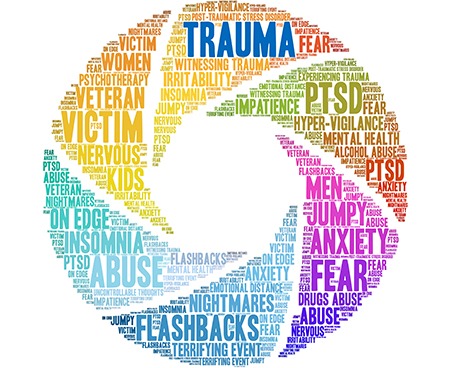Eye Movement Desensitization and Reprocessing (EMDR) is a gentle, neurobiological form of therapy that directly addresses and significantly reduces or eliminates the “fight, flight, or freeze response” in the brain caused by stress and trauma.
 Trauma can happen almost anywhere… or anytime.
Trauma can happen almost anywhere… or anytime.
Some types of trauma are obvious (“big T trauma”) – like physical and sexual assault, an unexpected loss, or a natural disaster.
But other trauma isn’t so “obvious” (“little T trauma”) – things like a vehicle accident, the end of a relationship, school or work bullying/harassment, misattunement with a caregiver in childhood, emotional neglect, moving (losing your social network), or witnessing violence at home or elsewhere.
Trauma can become deeply embedded in the body, causing stomachaches, headaches, migraines, pain, nightmares, panic attacks, and chronic illnesses.
Right now, memories of the traumatic event are the primary focus of your conscious and unconscious mind. Your thoughts are being filtered through the lens of those painful memories, effectively erasing the distinction between the past and the present.
Abby* (23) came to me struggling with CPTSD, sexual trauma, compulsive behaviors, and fear of abandonment. She realized she had endured years of narcissistic abuse contributing to her symptoms. Abby learned to value and love herself, set boundaries, and live a sober life of fun.
Marcus* (45) came to me seeking help with low self-esteem, depression, and to process a recent divorce. His self-doubt and fear of never being enough stemmed from childhood bullying. He learned to believe in himself and surround himself with people who value and treat him with kindness.
Channa* contacted me for EMDR to work through feelings of loss, disconnection from others, sadness, and self-sabotage. Channa had limiting beliefs that held her back from achieving her big dreams. She now has the career and freedom she always desired.
 EMDR can help you process and let go of the trauma.
EMDR can help you process and let go of the trauma.
In the late 1980s, Francine Shapiro, Ph.D., discovered a connection between bilateral stimulation and upsetting memories when walking in the park (walking is a natural form of bilateral stimulation). Randomized clinical trials and case studies then confirmed this hypothesis. This led to the development of EMDR.
Our brains have a natural way of recovering from traumatic memories and events. This process involves communication between the amygdala (the alarm signal for stressful events), the hippocampus (where safety and danger memories are created and stored), and the prefrontal cortex (which controls behavior and emotion).
Some events are so upsetting that the normal communication between these areas becomes blocked and cannot be processed without help. This stress response is part of our natural fight, flight, or freeze response. When distress from a disturbing event remains, the disturbing images, thoughts, and emotions may create feelings of overwhelm, of being back in that moment, or of being “frozen in time.”
EMDR therapy helps the brain process these memories and allows normal healing to resume. The experience is still remembered, but the original event’s fight, flight, or freeze response is resolved.
EMDR begins with gathering history and identifying possible targets to work on. I then help prepare you by teaching you skills and techniques so that you learn how to contain disturbing thoughts and find ways that help you feel safe. We then use bilateral stimulation to begin desensitization. The goal is to bring the distressing material down to a 0 or 1 on a scale of 10. We then replace the old negative beliefs with a new positive belief the client has chosen they want to believe about themselves that goes along with the target we are working on.
The trauma or distressing material is processed using bilateral stimulation, which, similar to REM sleep, helps the right and left hemispheres of the brain process and integrate the difficult experiences. EMDR works to connect the memory into what is called the “adaptive neural network.” The traumatic blocks are removed, and the brain’s natural healing can begin. The memory becomes part of narrative memory. A bad thing that happened a long time ago has no power anymore.
 The bilateral stimulation works quite well in an online format using an online platform called Remote EMDR with traditional eye movements (visual bilateral movements), Auditory bilateral, or self-tapping (tactile bilateral stimulation). I will help you decide which modality is best for you. The research and anecdotal information from my clients indicate that EMDR is remarkably effective in clearing trauma and distress from the nervous system when done online.
The bilateral stimulation works quite well in an online format using an online platform called Remote EMDR with traditional eye movements (visual bilateral movements), Auditory bilateral, or self-tapping (tactile bilateral stimulation). I will help you decide which modality is best for you. The research and anecdotal information from my clients indicate that EMDR is remarkably effective in clearing trauma and distress from the nervous system when done online.
EMDR can soothe you, improve your relationships, and heal your trauma.
What’s incredible is that EMDR can provide relief without forcing you to talk about the worst pain of your traumatic memories. This means that during processing, you are not required to verbally talk about your memories because your brain is doing all the processing. My job is to hold space for you while you process these memories and guide you to your new positive emotions.
When you reprocess painful memories…
You can permanently eliminate chronic symptoms like panic attacks, flashbacks, nightmares, intrusive memories, suicidal thoughts, self-injurious behaviors, anxiety, and emotional reactivity following traumatic or stressful experiences.
EMDR is also highly effective at targeting and removing long-standing “emotional blocks” like unhealthy thought patterns, compulsive behaviors, anxiety and depression, body image issues, phobias, and social anxiety.
You’ll also become more focused, centered, and at peace in your day-to-day life.
 If you’d like a more “intensive” EMDR experience…
If you’d like a more “intensive” EMDR experience…
Expect MASSIVE transformation. A way to heal from anxiety or trauma right now! I believe EMDR extended sessions/intensives are one of the most effective ways to heal quickly.
EMDR Therapy Intensives or “retreats” are designed for motivated individuals who want a lot of therapy in a short time. This unique approach offers a great choice for those with busy schedules or those who need relief quicker than traditional weekly sessions allow.
The great news is that EMDR Therapy Intensives are available for everyone and can be customized to fit your particular needs and schedule. I will design a plan to optimize and accelerate the treatment process, personalized for your specific needs, and will be your dedicated personal guide at every step.
When comparing Intensives compared to other trauma therapy, the intensive format may decrease treatment time because of time not spent on a) checking in at the beginning of each session, b) addressing current crises and concerns, c) focusing on stabilizing and coping skills that the client won’t need after trauma healing or d) assisting the client in regaining composure at the end of the session.
Your EMDR Intensive includes:
- Consultation and Assessment to assess whether EMDR is a good fit for your needs and identify the thoughts, beliefs, and emotions from which you are seeking relief.
- Personalized treatment workbook
- A customized treatment program with targeted treatment goals. Intensives are anywhere from 2 to 7 hours long over multiple days. Intensives are scheduled with advance notice.
- Post-treatment interview to assess and support your adaption to positive changes from treatment and access any needed follow-up sessions.
- Intensives must be booked in advance, depending on availability. Session times vary depending on client needs.
How much does it cost?
Full-day, In person intensive: $2,148
This includes 90 minute assessment for gathering history and setting up targets, and 6 hours of therapy with a 1-hour break for lunch and stretch/bathroom breaks, as needed.
Half-day, virtual intensive: $1,228
This includes 90 minute assessment for gathering history and setting up targets, and 3 hours of therapy with one 15-minute break and additional stretch/bathroom breaks as needed.
*Individuals can attend In person Intensives in Austin,Texas or Costa Rica set up as a Retreat.
How do you prepare for an intensive?
EMDR intensive sessions are similar to going on a personal spiritual retreat. It’s best to allow time outside sessions to be unscheduled or filled only with self-care activities like exercise, bodywork (cranial sacral therapy, acupuncture, or massage), and creative expression – dancing, drawing, painting, and cooking.
 I believe in EMDR because it changed my life!
I believe in EMDR because it changed my life!
After years of talk therapy and feeling stuck in my head, constantly analyzing myself, and frustrated with nothing changing, I found EMDR.
After five months of EMDR, I found incredible healing and let go of big pieces of my trauma, allowing me to feel peace, joy, and control of my life. I learned I could create the life I wanted without carrying around 1000 lbs. of trauma. I released the pain that had been buried deep for so long.
It changed my life so much that I couldn’t wait to learn and practice EMDR to help others the way it helped me!
Stop the cycle of fear and begin living confidently again!
Let’s get healed!
There is no reason to sit in your pain any longer. Call me at (209) 791-6191 to set up a free 30-minute consultation to discuss your needs and see if we are a good fit to work together.
*Names changed to preserve client confidentiality.

